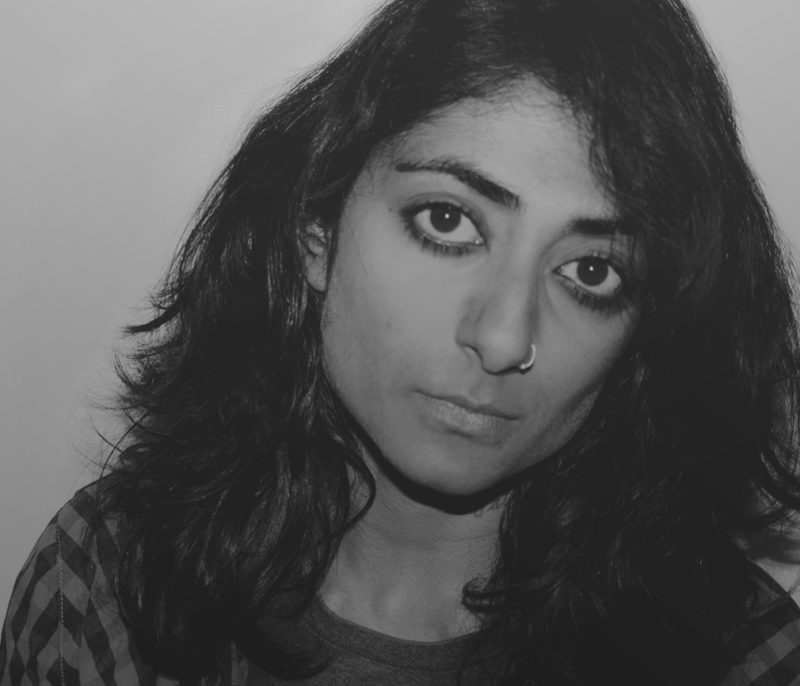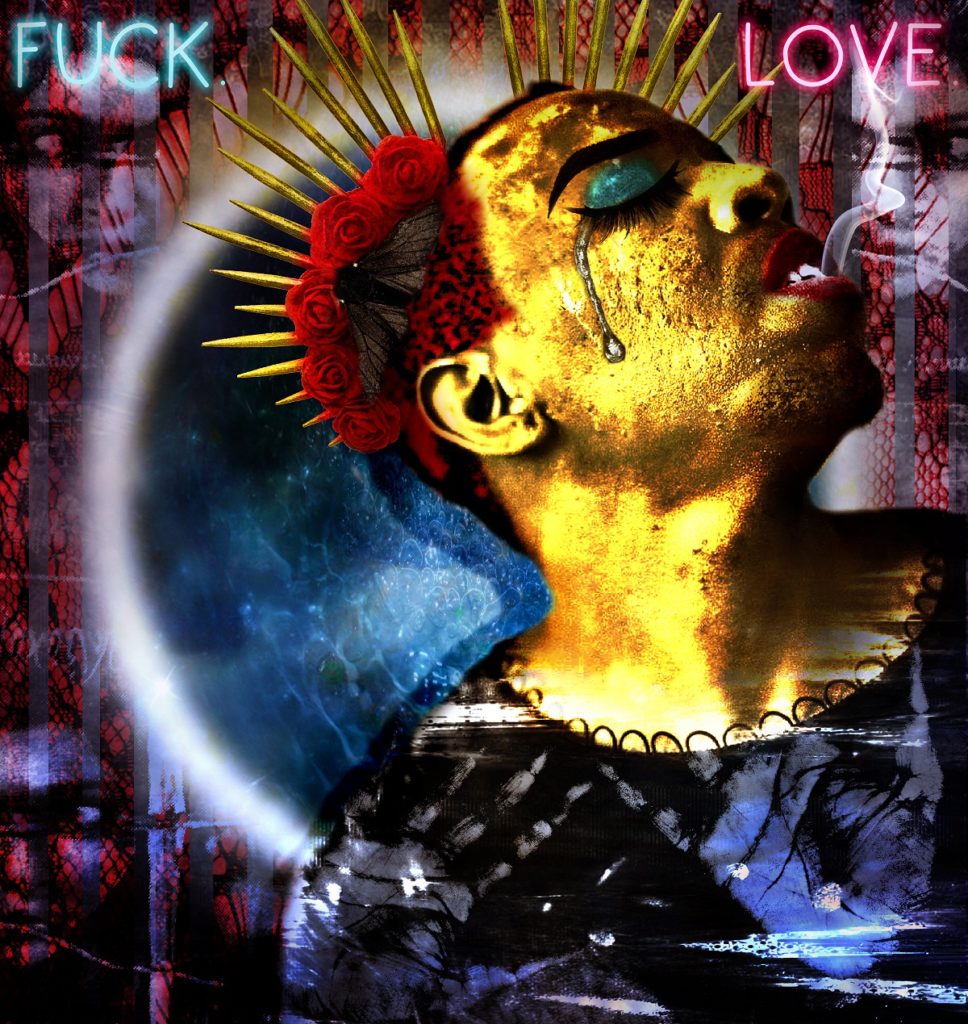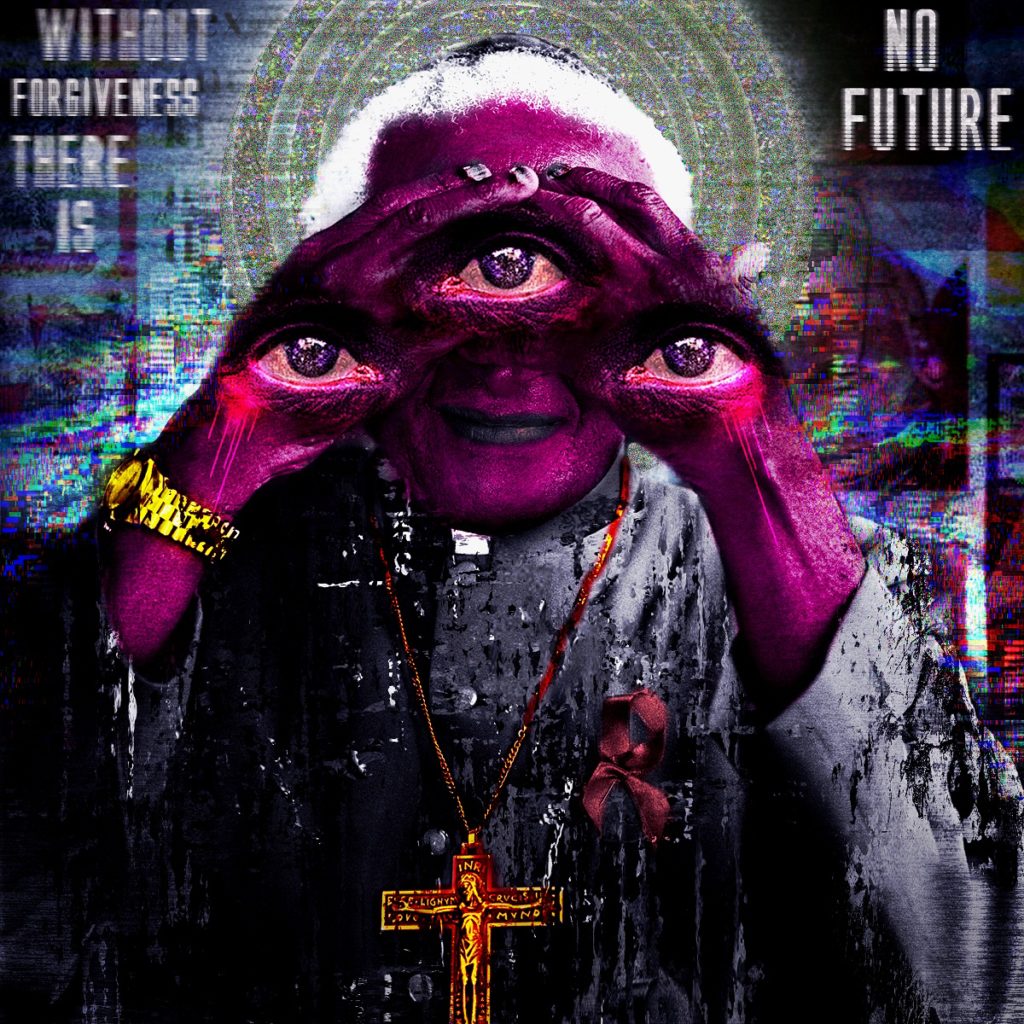Tell us a little bit about your background.
I am a self-taught alternative visual artist currently based in Johannesburg, South Africa. I have been drawing since I was a child. I studied Psychology and Media Studies at the University of Witswaterstrand from 2005-2010. It was only in my final year, when I was deep in socio-critical theory, that I realised a truth about reality and our fear-based society that resonated within me. This led me to start illustrating the emotions and thoughts in my reality.
I saw similar styles and emotions in the gig posters used to promote bands. I thought to myself: “Okay there is a way I can share and display the messages of my art; people make beats about this stuff!” I was also really inspired by Nan Goldin’s photography, so I played around with a camera for a while. But found it too intimating to take pictures of people; I was not as comfortable with photography as I was with sketching.
One day, I was messing around with an image on my PC, combining my sketches with the photo. The outcome was dark, surreal, and romantic; a lifeform that showed itself to me. I fell in love.
What inspired you to be an artist when you were growing up and why?
I grew up in Lenasia South, in Johannesburg. It was during the early 2000s (I was a teenager then), and growing up in this area was boring and really lonely for me. I was also the introverted, weird, and angry kid who believed in magik and that Alanis Morissette was my angel. There was no alternative, no grunge visual culture such as music, graffiti, and posters on the street poles. All I had were the Simunye Grooves CDs and MTV.
I was continuously pressured to fit into the Typical Indian Girl mould, which was: study, dress pretty, have lots of money, and get married. I wanted to escape. I had met a soul-friend in my final year of high school. She was the only girl who got my weirdness and loved it. And in that love I found power. Her love for music opened the door to my love for poetry, alternative music, trip-hop, and punk culture. I started making indie comics and playlists for her.
Collecting music led me to live music, club culture, and album and graphic Art. I finally found a place where I belonged. I finally understood the beauty that lies in darkness. This inspired me to create my craft, to shine light into dark places, to address the social oppressions that women have to endure daily. And to help young women believe in themselves enough that they break their silences.
What is the most challenging aspect of being an artist, particularly as a woman, in your country?
I feel female artists are very segregated, disrespected and stereotyped in South Africa. Firstly, it is really difficult to find female visual artists, unless they are made popular by the media. And the only time a female artist is celebrated by the media is during Women’s History month, or in theme-based parties, or as a sex symbol – and that is if they know how to market themselves. There is a noticeable amount of gender inequality.
If you looked at a visual art exhibition, for example, it will be highly dominated by male artists and maybe one female artist. I feel that there is no encouragement for women to come out more and share and collaborate in their craft so that we don’t have to see the same artists all the time.
I think women artists have to work a bit smarter and harder, because we are breaking the brand of the masculinity-centric society that we live in. I feel that all artistic voices should be recognised equally. It should not matter if we are women or men, self-taught or college-educated. What should be recognised is our passion for pushing the human potential.
Are you involved in any other projects outside your regular job? If so, can you tell us which ones you’re currently most excited about?
Yeah, I am currently involved is a Visual Art and Contemporary Dance collaboration with choreographer and contemporary dancer Thamsanqa (Thami) Majela. I really enjoy Thami’s work. This project in particular, because it speaks to something we both experience and are aware of: the extremes that one experiences in depressed masculinity and feminity.
This performance will be shown in South Africa at the My Body, My Space festival in Mpumalanga. I am also creating a photo-manipulation portrait series where I work with children and women in townships and villages sharing the stories unique to their identity as human beings.
What strategies do you use to carve out time for sketching?
My strategies are rooted in reducing the anxiety that comes about because of working alone and having to discipline myself. Before I start any work, I first make sure I am mentally healthy to do so. I work out and meditate, ensure I have coffee, and always play a movie or an album in the background to eliminate PC noises and the voices who make noise in my head.
Once I am in the zone, I am complete. However, it is critical to step outside and see daylight when the struggle does eventually present itself. Sometimes that’s done in the form of scratching my dog’s belly, sometimes it’s done in the form of YouTube videos. After sketching is done, I always makes sure I clean my work space. I reward myself by being in nature. For me, it is very important to balance my eyesight with man-made light and natural light.
Are there any TV shows, movies or web series you would sneak out to watch right now?
Definitely. The TV series OZ. I always find myself going back to OZ. I think the more I develop in myself, the more I listen to it. It blows my mind all the time. That and the movie Gattaca.
Who are the most exciting artists on the South African scene right now?
I would say Vusi Beauchamp, Ayanda Mabulu, Zanele Muholi and Naomi Van Niekerk.
What was the most discouraging time in your career and how did you overcome it?
Shoo! I think the most discouraged I have been was when my artwork was selected for The Burning Question, an exhibition about climate change danger featured at the 2017 MTN Bush Fire fesitival. My family did not support my passion for making art at all and made it difficult for me to be at the exhibition. It broke my heart because here I was trying to do something that would make a huge impact on people. Instead, I was being judged and belittled, told to “get a real job”. Naturally, I feel into a depression and it really hurt. Even when I was eventually able to go to the festival, I was still depressed and disappointed – and stayed that way for about two months thereafter.
In the course of those two months I still created art, but I was now starting to fear sharing my work and exhibiting because I was afraid I would be hurt like that again. My art then became a container that turned my anger into something like a bubblegum milkshake. It was the only space I found in my loneliness that understood me. I eventually found myself again and I accepted that that which makes me feel happy is much more important that making others happy. I accepted myself and that I can’t change for anyone. The truth is in staying true to myself.
Looking back, is there anything in your career that you would do differently? Any major decisions you regret?
I don’t regret anything because everything has been a lesson to learn in becoming a better artist. There are definitely things I would have done differently. One thing I learnt is never do anything out of desperation because it makes you do things you don’t want to do – giving away your value for way lower than what it is worth.
What is it you would most want to be remembered for when you’re gone?
Reminding people of the light inside them.

Africa. She is founder of Tred in Mental, a graphic art free space which encourages the freedom
to create visual poetry through graphic art, fantasy, humour and the appreciation for the Human
Race.
Tamara’s artwork shares a visual culture, of the state of being, through Graphic Posters. Her
artwork questions the way we are socially conditioned to belong as people; to seek truth. All
design work is created as an alternative form of visual education for children and young adults
in raising awareness to the strengths and weaknesses of our current social conditions. Human
development can go through extreme measures to have purpose in this world. Eco Terrorism,
Women abuse, racism, corrective rape, child abuse, thought disorders, suicide, anger and
loneliness are a few of these extremities. Tamara’s visual identity is dedicated to shining a light
in a dark place. It is important to find and create beauty because of how ‘real’ life can get. Her
artwork aims to connect to great hearts and innovative minds in pushing the human race
forward through the freedom of Expression. Tamara’s gift is to share a world of magick through
the use of colour and imagination.
Her portfolio includes design work for print, posters, album art, comics and illustration; and video
art.



